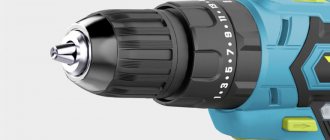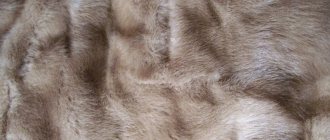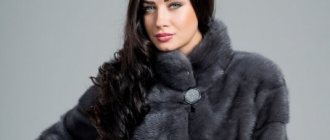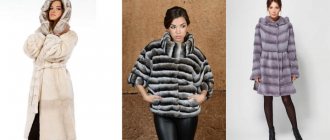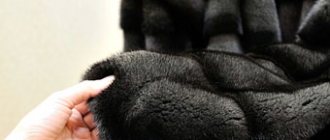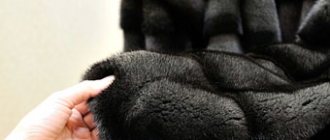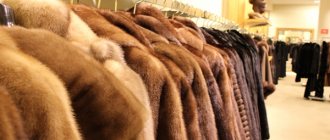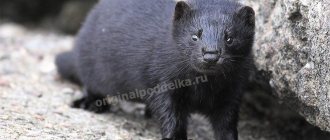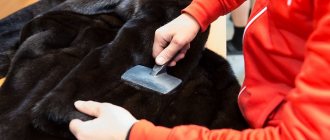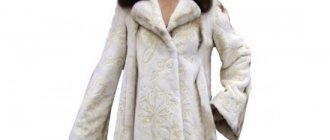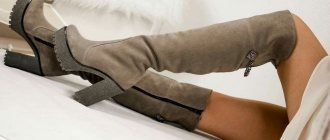Good clothes made from natural fur are always a very profitable purchase. And even more so a good mink coat. This is a classic of the fur market, always fashionable, in demand and loved all over the world, which will not only warm you up in the cold, but also emphasize your beauty and individuality. Such clothes will serve you faithfully for many years if you follow simple rules of care and storage.
Choosing a mink coat
To choose a good quality mink coat, you need some skills and knowledge, without which you risk paying a lot of money for a fake - mink models, like no other natural fur products, are susceptible to counterfeiting. Moreover, not only skillfully crafted fur from other animals, but also products made from artificial fur are sometimes passed off as natural mink! So, how to avoid becoming a victim of scammers?
Beautiful fur coat
How to determine the quality of fur
First of all, when buying a fur coat made from natural fur, you must make sure that the fur is truly natural and of high quality. To do this, do not hesitate to take a good look at the fur, touch it and even smell it.
- First of all, look at the color and texture of the fur. If it is dull, not soft enough, the fibers stick together, this should alert you. Natural high-quality mink fur shimmers and shines evenly, easily squeezes in a fist and immediately straightens.
How to distinguish a mink coat from a rabbit coat
A fur coat is every woman's dream. After all, high-quality fur adds more sophistication and charm to any look, and most importantly, never goes out of fashion. But before you buy your dream, be sure to think about where is the best place to do it? You should not go to the market, because this is where, according to experts, they most often try to sell low-quality goods or counterfeits. It is also better to ignore the method of purchasing through a private advertisement. Try to find a reliable store that has established itself as a professional and honest fur seller. A good example is the “Your Fur Coat” store - they offer cheap mink coats at competitive prices. He will be able to provide you with all the necessary documents for the products and give additional guarantees. Unfortunately, nowadays you can come across fakes even in expensive boutiques, so when choosing, it is very important to focus not on labels or brand tags, but on your own theoretical knowledge and tactile sensations. What should you pay attention to first?
Lining
Particular attention should be paid to the lining; look under it and pay attention to the shape of the skins. By their form you can determine whether the seller is deceiving you or not. For a mink, it should be trapezoidal, about 10-15 cm wide, and about 60 cm long. The muskrat has the shape of a hexagon, a nutria-square. Rabbit skin is identical to mink, but is slightly larger in size. Some manufacturers sew the hem completely. This does not prove that they are selling a fake. But if you are in doubt, it is better to avoid such products.
Mezdra
Be sure to inspect the inside of the fur coat by lifting the hem of the lining. If it is sewn, then simply spread the fur from the outside. For a mink, it will be velvety, soft to the touch, and the color will be light and creamy. The darker it is, the older your fur coat is. Make sure there are no creases on it. Otherwise, it will lead to rapid wear or holes.
You can also understand whether there is a mink in front of you or not using tactile sensations. Her fur is delicate and soft, but can be a little itchy. It has a uniform color and white, small hairs. If you stroke it against hair growth, the elastic fur tends to immediately return to its previous position. The rabbit's hair is so fluffy and soft that it doesn't prick even after being cut. Squeeze a piece of leather and fur in one fist. If, when unclenched, it remains in the same crumpled state, then this means that there is a rabbit in front of you.
Mink has a winter and summer undercoat. Its winter one is thicker than its summer one. The rabbit has practically no undercoat. Spread the lint with your fingers and see if it is inside.
General Tips
They may offer you a marmot under the guise of a mink. Outwardly, it is very similar, but it will not be as soft to the touch due to the different length of the fibers. Also, a painted marmot has a slightly purple or blue tint.
A real mink fur coat must shine.
Check the color quality. Run a white napkin or handkerchief over your fur coat. There should be no traces of paint left on it.
Gently pinch the hairs. There should be no fur left in your hand. If it remains, it means that you are looking at a low-quality fur coat or a mink obtained during the molting season. Such a product risks remaining pretty bald by the next season.
Shake your fur coat. It should not rattle, rustle or rustle. Also, a mink coat should be much lighter than others.
Be sure to smell your purchase. You should not notice any chemical odors or dried animal fat.
Wrinkled armpits indicate that someone has already worn this product.
Check all seams. They should not be half-loose or with protruding threads, but beautiful and neat. Experts believe that ideally the lining should be sewn on by hand through bias tape.
Read the labels carefully. They must contain all the information about the fur and its manufacturer. For auction fur, look for an additional label.
A fur coat made from the backs is considered the most wear-resistant and expensive. It can last you up to 14 winters.
Armed with this knowledge, now you can definitely buy the mink coat of your dreams and not overpay for a fake. I wish you success!
Source
Self-assessment of fur quality
Let's try to determine the quality ourselves. The method is suitable for both individual skins and the entire product.
We evaluate it by touch.
Good quality fur feels smooth and soft to the touch. Moderately pliable, the fibers should return to their previous position when you run your hand over it. It should sting a little. Less wear-resistant fur, the same rabbit, softer and not itchy. Also look at the undercoat to see if it is thick enough.
Important: Good fur does not need painting. They cut and dye to disguise defects.
Let's look at the undercoat.
Mink comes in winter and summer. They differ in pile and undercoat. The winter coat has a thicker undercoat, is warmer, and costs less. Summer mink has a smoother, even and shiny appearance, there is less undercoat, and it costs more.
We check the flesh.
The mezdra is the lower part of the skin. She talks about age. Choose only products and skins with light, elastic core. Dark, brown - indicates the old age of the fur.
We evaluate visually.
Look at the coat or skin as a whole. The fur should be uniform and even. The fur on the back is denser and smoother. Lobes, bellies and other parts are less durable and beautiful. But they are significantly cheaper.
Important: The product made from the backs has absolutely no visible joints or undercoat. It gives the impression of cast skin. The coat of parts looks as if it is sewn from small semicircles, and it looks wavy.
How to identify real mink fur and distinguish it from a fake
The marking must contain the individual number of the fur product
Nowadays, marking a fur coat is a kind of quality mark by which you can both identify mink fur and gain confidence in your purchase.
Nowadays, finding high-quality mink skin is very problematic, not to mention the product itself from the cute animal. Unscrupulous manufacturers of mink products offer their cheap analogues. It’s so easy to confuse the fur of a marmot or beaver, after a little processing, with the fur of everyone’s favorite predator. But, as the famous proverb says: “Forewarned is forearmed!” Which we will discuss below.
Knitted fur
In fact, knitted fur is a special fur yarn from which fur products are made that are extremely similar in quality and appearance to knitted items.
The patent for the invention of knitted fur belongs to Paula Lishtman, who until the end of the last century carefully hid the secret of making fur “yarn.” To work, take the largest large rabbit skins (beaver, mink), pluck them, after which a thin long continuous thread is cut out of the skin in a spiral, which is twisted into a ball. The process, of course, does not stop there. Next, the base of their cotton thread is created, the so-called mesh of the product, onto which the finest fur thread is “tied”. The fur knitwear obtained in this way is soft not only on the outside, but also on the inside, since the fur thread is twisted and its fluffy side is located both outside the product and partially inside. Sweaters, light jackets, suits using knitted fur technology were “painted” with rhombuses and openwork patterns, that is, with all the attributes of knitted products. Knitted fur items are durable, suitable for everyday wear, practical, and at the same time completely unique, since you can choose a new pattern each time to create them. Such stylish items are suitable for a business reception, but it is also convenient for an ordinary country trip, and those who have items made of knitted fur sometimes consider them a “second skin” because of their plasticity, lightness and extraordinary softness.
How to distinguish mink from fake
Experts say that it won’t be difficult to distinguish a first-class mink from, say, a third-class mink, because you won’t want to let go of high-quality natural fur. But, all the same, it is better to know about some nuances, thanks to which you yourself can become an expert in choosing this product:
When carried out, as they say, “with the grain and against the grain,” you should feel soft and silky. If you can feel two layers of fur that are different from each other (guard hairs and undercoat) and each hair is approximately the same length, then the quality speaks for itself and is rated 5 points.
The pile does not recover on its own after being attacked, which means that the storage conditions have been violated. This may be a consequence of being folded for a long time.
When held up to the light, the fur should shimmer and shine. Also, the direction should be in one direction and uniform. You can also blow on the mink, thereby checking whether the hairs stick together or not. In the original fur, the fibers should not stick together, but in the analogue, yes.
The color of the mink should not be too deep black. Manufacturers, trying to disguise fur as mink, dye it in different shades. This is checked with a white or light rag; if after rubbing the skin the material remains clean, then no dyes were used.
What does real mink fur look like?
When choosing fur, you need to lightly wrinkle it. High-quality material is distinguished by soft, dense pile with a thick undercoat. By holding the fur up to the light, you can see how it shimmers, the fibers do not get knocked out and are located strictly in the direction of the growth of the pile (see photo). The natural colors of mink range from dark brown to café au lait. Black mink is obtained as a result of dyeing, gray mink is obtained through the selection of fur-bearing animals.
Walking your palm over the fur surface, you need to see if there are any lint left on it and if the skin has become stained. Such phenomena indicate the artificial origin of fur. Good pile, after being crushed or blown on, does not stick together and quickly regains its shape. When you feel the product, you feel the velvety and uniformity of the pile, since the fibers are of the same length. When creasing and shaking the item, the fur should not make any sounds.
The fur coat is made from pieces of fur, each of which is stamped with the manufacturer's stamp. The seams of a good product are almost invisible, the edges of the flaps are smooth and do not diverge, because they are cut with a laser device. A quality item consists of stitched, not glued, skins.
How to distinguish Chinese mink
It is known that the cost of Chinese mink coats is much less than European ones. Although China has learned to produce high-quality products from the mink industry, there are still a huge number of fakes. But there are also plenty of fakes among them.
In materials from the cheaper segment, the mink is tinted or tinted to be sold as black.
Below are some aspects by which Chinese mink is identified:
These signs make it clear that the animal was raised in the Republic of China. It is known that it differs from the Chinese in the thickness and longness of the pile, while the U has a short but thick pile. A huge percentage of mink products are black skins with a defect called “unproduced awn,” which to amateurs may resemble North American mink skins.
Video: Fur coats: how not to buy a fake that you’ve been saving for for so long
What to look for when buying a fur coat?
A high-quality mink coat must meet the following criteria:
- Resistance to deformation. Natural fur is resistant to creases and quickly restores its shape after being wrinkled. If you tug lightly, not to mention running your palm over the fur surface, the fibers do not come off, because they are securely held in the fur.
- Pile structure. Natural fibers taper towards the tip, artificial ones do not.
- The smell of the material. A quality product does not emit any odor. A chemical smell indicates a fake or that the material has been painted. To recognize a fake, you need to set fire to a few fibers. Natural fur burns completely and gives off the smell of burnt hair, while artificial fur melts and smells like plastic.
- The weight of the item. Natural mink is much lighter than other types of fur, both natural and artificial.
- The presence of a label indicating information about the manufacturer. Fur from Scandinavian manufacturers is especially valued. It is also necessary to inspect the pieces of flesh for the presence of manufacturer's seals.
To check the quality of dyeing, you need to wipe the fur with a damp cloth. If the white material is even slightly colored, you can be sure that the seller is offering a fake or poorly dyed natural fur. It must be taken into account that even well-dyed fur lasts 5–7 years less than natural-colored material that has not been dyed.
How to distinguish mink from other fur
In order to warm not only the body, but also the soul in the winter cold, you should know the difference between expensive and cheap fur. This can be done easily if you remember the following signs:
Today, mink coats have gained popularity in fashion trends. They received their status due to their solidity and investment character. Unlike down jackets and fur coats of other animals, mink coats are durable.
How to recognize good mink fur
Initially, it is worth finding out the gender of the mink animal, as this is reflected in the texture of the fur. Fur made from the skins of a female is considered to be of the best quality; the products are soft and light. In males, the fur is tougher and denser, so the skins are heavy and are cut more often.
The difference between a good mink coat
A good mink coat looks expensive and rich. The quality is visible in everything: cut, tailoring, details and the level of the fur itself. The fur coat must be sewn from solid plates, from the backs. This is the most wear-resistant and beautiful option.
Sometimes a fur coat is sewn unraveled. For this technology, the skins are cut into a herringbone pattern and stitched back together. On the one hand, the fur coat has a flying silhouette, but, on the other hand, the product itself is less durable. If sewing is of poor quality, furrows may appear after the first season. When choosing such a model, pay special attention to the quality of the seams.
A good fur coat is well made. No protruding threads, no loose seams. The seams should not be visible at all. Expensive lining. After all, a fur coat is bought to last for many years, and the lining should also not wear out ahead of time.
Pay attention to the style. Super fashionable tailoring can look outdated after 1-2 seasons. If you do not plan to change your fur coat often, give preference to the classics.
Important: According to statistics, the most popular fur coat model is knee-length and with a hood. It's warm and you don't have to buy a hat.
A good fur coat is unlikely to be made in a handicraft industry. The master must understand furs, be able to select skins by color and quality for one product, and know all the intricacies of technology. Knowledge and skills are acquired over years and no one will exchange them for sewing low-quality products. Large showrooms work directly with well-known factories, offering customers the best models.
How to distinguish sheared mink from other fur
Initially, what you need to pay attention to when choosing a mink is the weight of the product. Mink is much lighter than any other fur. Very often, manufacturers camouflage themselves with the fur of a rabbit, beaver, ferret or marmot. Therefore, it is so important to know their main differences in order to avoid counterfeiting.
When choosing mink fur, you should not rush; now you know simple methods; you should use all your senses to find the right model. After all, in order to make a profitable purchase, you need to be attentive to the details.
At all times, a woman remains a woman, even in our time, buying a mink coat is the dream of many of our contemporaries. A product made from the real fur of this valuable fur-bearing animal cannot cost little, so some ladies save money for a very long time, sometimes even denying themselves something to buy a mink. Imagine the disappointment when, instead of a mink coat, they are given clothes made of lower quality fur. To prevent this from happening, you need to know a few simple rules that will help determine whether real fur served as the material for a given product.
At all times, a woman remains a woman, even in our time, buying a mink coat is the dream of many of our contemporaries. This valuable fur-bearing animal cannot be cheap, so some ladies save money for a very long time, sometimes even denying themselves something to buy a mink. Imagine the disappointment when, instead of a mink coat, they are given clothes made of lower quality fur. To prevent this from happening, you need to know a few simple rules that will help determine whether real fur served as the material for a given product.
What kind of fur are fake mink made from? We have already written about how to identify high-quality mink fur. But many of our inexperienced women cannot immediately determine whether the mink coat they have in their hands is real or not, until they know what a fake looks like. To do this, you need to know what furs fakes are made from and how to identify them: Rabbit. The main difference is the very soft pile of rabbit fur. It is also worth paying attention to the color; in a rabbit it is not uniform and does not have the uniform shine that mink has. If you pluck a mink coat, there will be no hair left in your hands, while a rabbit leaves behind lint of undercoat; Beaver. The fur of this animal is tougher, its skins are larger. But the main difference is in the thickness of the mesra (the leathery base of the fur) - in a beaver it is several times greater than in a mink; Marmot. The fur of this animal is most often passed off as mink. The difference is in the plasticity of the fur. When stroking against the grain, the mink's fibers return to their place, and the marmot will become shaggy. In addition, the marmot can tingle and give a slightly bluish tint in the sun, which never happens in high-quality mink fur; Ferret. This fur can be distinguished by its higher guard and less dense underfur. The color is also different: the awn is darker at the ends, and the underfur is lighter. By the way, products made from ferrets are no less valuable, but if you are only interested in buying a mink coat, then you need to know the differences. There is one more nuance: if you have any doubts about fur, then you should pay attention to the style. Only straight fur coats are made from ferrets, due to the rare nature of the fur; Honorik. The most difficult case to determine the authenticity of the product, since this animal is the result of crossing a ferret and a mink. But the black color and thick brown undercoat indicate a fake. The easiest way to determine the authenticity of a product is by cost and weight. A real mink coat, the price of which cannot be low, is light. How to identify a Chinese mink coat? To be fair, it should be said that the Celestial Empire has learned to sew high-quality products. But very few manufacturers can boast of this. Therefore, if you decide to buy a mink coat from Canada or Greece, it will be very disappointing to buy a Chinese product. It will not last as long and will quickly lose its appearance. The main differences in the Chinese mink coat are: A pronounced high spine, which may even seem prickly in appearance; Chinese fur coats, for example, are very different from Scandinavian ones in their shine. For the latter, it is soft, diamond-like, and flows smoothly throughout the entire product. Chinese mink has a glassy sheen. The product shines in areas, and there can be no talk of any smooth shimmer; Undercoat. If the guard is high, the undercoat will not be thick enough. In some cases, the spine is cut off and the product is passed off as black mink. You can distinguish it by the color of the flesh. Natural black mink is light, while Chinese mink is dark. Using this knowledge, it is much easier not to fall prey to unscrupulous manufacturers and sellers. Remember that if you buy a genuine mink coat, it will make a queen out of a woman, and a fake will only bring disappointment.
How not to buy a rabbit instead of a mink?
The rabbit is more suitable as a cheap analogue of the chinchilla, especially the Rex breed. But they also pass it off as a mink, usually as a sheared one. The rabbit is not a bad animal. It grows quickly and is soft to the touch. Its price is one of the lowest on the fur market. It is not at all shameful for a young girl to have a vest or purse made of rabbit. It’s worse if, under the guise of an expensive and high-quality mink, they offer a rabbit fur coat. Lack of experience leads to the purchase of such “mink coats”. But this can be avoided. You must use keen eyes and a skeptical attitude.
• You can tell a rabbit from a mink by eye. Rabbit fur is soft and fluffy. Looks like cotton balls. Has virtually no undercoat. To bring the rabbit closer to the shorter hair of the mink, it is plucked. Spread the pile, look inside it to see if there is undercoat.
• Look at the color. The rabbit is one color, and the mink has small white hairs. The fur coat itself does not “play” in the sun and has no shine.
• The next test is by touch. Rabbit is much softer than mink. Feel more fur coats, after 10 you will understand where the fur is soft and where it is harder.
Possible defects
You can avoid buying a fake if you know the common defects in mink fur. This should include:
If at least one of the presented flaws occurs, then it is better to refuse to purchase this product.
Verification methods
There are certain secrets regarding how to check a mink coat. Today, many unscrupulous manufacturers are trying in every possible way to disguise the existing flaw. They paint the faded parts of the fibers or cover them with a special varnish, which gives the product luster and gloss.
How to check the quality of a mink coat? It is enough to use the following recommendations:
Useful tips when buying a fur product, details in the video:
Lining quality
When purchasing mink fur outerwear, it is important to pay attention not only to the condition of the fur, but also to the lining. If the product is really high quality, then you should pay attention to the following points:
Types of mink
A wide selection of mink allows you to sew a fur coat that will be ideal for wearing in a certain climatic zone.
Russian
This fur has remained one of the warmest for many years. It is distinguished by a high awn and underfur, so that its appearance seems a little tousled. Its price is quite affordable, and the range is wide.
Scandinavian
This type of mink accounts for 80% of all fur sold in the world. Characterized by a medium awn and thick underfur. How to identify mink fur? Everything is very simple: you need to inspect its surfaces. Scandinavian fur has a chic shine, which is why the product is popularly called “black diamond”.
Chinese
For those who do not understand how to identify a good mink coat, it is worth remembering one rule: do not purchase Chinese-made products in the markets. China produces high-quality mink, but increased demand does not allow it to be exported outside the country. Only low-quality budget products are supplied abroad. In addition, Chinese manufacturers stretch the fur, as a result of which it becomes brittle, the service life is reduced and, as a result, it does not warm.
North American
Determining the quality of fur is very simple. It has low pile, but there is no shine at all. Most often, such a product is called velvet. The peculiarity of the North American mink is that it is perfect for the harsh Russian winters.
wild
How to check for quality? Don’t think that the more expensive it is, the better the quality. This type of fur is considered rare. It is characterized by a long pile, almost the same as that of sable. Its color is dark gray-brown. It is also distinguished by its light underfur. Wild fur has a lot of flaws, because to obtain a fur coat you need a large number of skins. Consequently, the price of such products is high.
Italian and Greek
In Italy they do not farm mink. But this does not prevent local craftsmen from creating excellent samples with an original design. Currently, the quality of such fur coats pleases all fashionistas both in Russia and abroad. If you do not understand how to correctly determine the quality of a mink coat, then you should buy such clothes in stores at fur factories.
Mink fur is in great demand today when sewing winter clothes. But due to high competition in the market, some manufacturers resort to certain tricks. They reduce the cost of the product because they themselves purchase a low-quality product. In order not to fall for the tricks of scammers, you need to learn how to identify quality fur. This is not difficult, but it will protect you from counterfeiting and financial waste.
How to choose a quality product, details in the video:
Source
What fur is most often passed off as mink and what are the differences between them?
Under the guise of mink, they often sell both artificial fur and fakes made from cheaper varieties of fur - rabbit, beaver, nutria, etc. To distinguish a fake, you need to pay attention to the color and elasticity of the flesh (in mink it is light and soft), uniformity color and uniformity of fur shine, fur acquiring an atypical shade in natural light, etc.
Cheap rabbit instead of expensive mink
Because of its low cost, mink is most often replaced with sheared rabbit. If you shake the item or run your palm over its surface, rabbit fur falls off easily, unlike mink. Thanks to the lush undercoat, the rabbit is more soft and voluminous, but quickly loses its attractive appearance. When purchasing, you need to pay attention to the shine of the material (in rabbits it is dull) and the ability to restore its shape after creasing - a dent remains on the rabbit hair, so it needs to be combed with a soft brush.
Sheared beaver fur
To distinguish a mink from a fake beaver, when buying a fur coat, be sure to pay attention to the length of the pile and the thickness of the fur. For mink, these figures are up to 10 cm and 1–1.5 cm, respectively, for beaver – up to 15 cm and about 1.5–2.5 cm. Beaver fur is characterized by uneven color, which cannot be eliminated even by bleaching. Mink is characterized by a uniform color. The flesh of a mink is soft and elastic, while that of a beaver is tight and thick. Beaver hairs are hard, which is due to their shearing.
Nutria or mink?
Nutria is often passed off as a mink. The fake is usually made from shorn nutria. With this procedure, nutria acquires an appearance that is as close as possible to mink, but it also becomes prickly, and its performance properties are significantly reduced. A nutria fur coat is warm, but heavy, unlike mink. It can also be recognized by its specific smell, which cannot always be eliminated during the tanning process.
How else do you fake mink?
Mink is also counterfeited, passing off as the fur of such fur-bearing animals as:
Muskrat
- Muskrat. Thanks to the thick dense undercoat, it is characterized by high thermal insulation properties, shine and softness of the pile, like mink. The maximum similarity between a muskrat and a mink is achieved by cutting and dyeing. The natural color of this material ranges from dark brown to black. The disadvantage of the muskrat is its short service life - 4-5 seasons.
Groundhog fur
- Marmot. It is characterized by lightness, which is why it is often faked as mink. During the processing process, the fur is cut to make it uniform, since the fibers have different lengths, and dyed, which is why the fur acquires a bluish tint. Marmot pile is more elastic, so it does not return to its original shape after being crushed, but bristles in different directions. A high-quality mink protects in the most severe frosts, while a marmot can only be worn down to -10 degrees.
Faux mink fur
- Faux mink fur. The artificial material replicates the structure of the pile and the color of natural fur, but it cannot protect against frost below -10–15 degrees and quickly loses its attractive appearance. When buying, you need to pay attention to the shine of the fur - in artificial fur it is duller and glassy, and not glossy, like in natural fur. By pulling apart the faux fur fibers, you can discover the absence of dense undercoat, which provides the high thermal insulation properties of mink. Such a fur coat can be distinguished by its greater weight than that of real fur.
